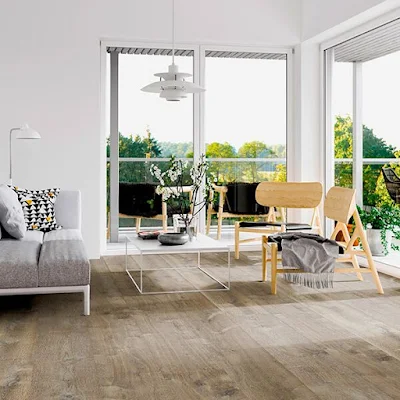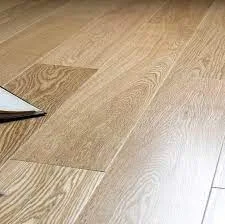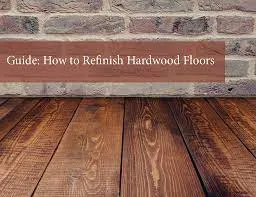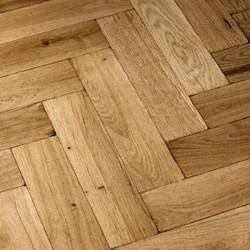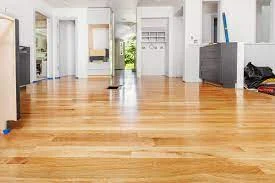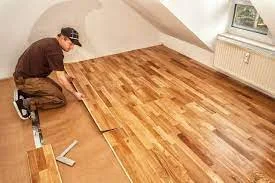Straightforward Guide to Wood Flooring
On the off chance that you've generally ached for hardwood floors, you're following some great people's example. While delicate wooden floors date back to the Colonial period, hardwood floors previously burst on the scene in the late seventeenth century. On the off chance that you just realize that you need hardwood floors gracing your home, read this down to business guide so your head will not turn when you talk with your project worker. This ten-minute read will direct you through the essentials of wood species, grades, types and styles.
Wood Species
With more than 50 wood species accessible for wood flooring, red oak represents over half of hard wood flooring deals. Its fame comes from its style, toughness and cost-adequacy. Maple positions second in prevalence for new wood flooring. Fresher patterns demonstrate a developing hunger for bamboo, cherry, and white oak. A portion of the more recondite imported woods utilized in hardwood floors incorporate Brazilian cherry, Australian cypress, African padauk, and Burmese teak. Shading choices are abundant. On the off chance that tone is a need, and you need the regular magnificence of the wood to radiate through, select a wood animal categories that most intently coordinates with your shading inclination.Wood Grades
Grade alludes just to the magnificence of the wood, not to its solidness or workableness. Only one out of every odd grade applies to each wood species. A wood animal types is reviewed as Clear, Select or Common, or it is evaluated as First, Second or Third. Clear/First, Select/Second, Common/Third grades are not indistinguishable, yet they are sufficiently close to introduce a common shopper definition. The six essential wood grades include: - Clear or First - liberated from most apparent deformities and staining, contains just minor noticeable flaws - Select or Second - may contain slight defects, for example, shading varieties - Common or Third - contains bunches and shading varieties, frequently named "natural" wood
Strong versus Designed Wood
Numerous individuals accept that hardwood and strong wood are equivalent. They're not. In case you're hearing the term designed wood interestingly, you in all probability believe that it is some way or another substandard compared to strong wood. That is not really obvious. Strong wood is processed from one strong ¾" piece of wood. Strong hardwood floors extend and contract more than designed woods and are especially vulnerable to dampness. As the wood grows and contracts, it might clasp or it might leave holes. Two normal techniques for checking these holes incorporate slanted edges and leaving development holes - holes between the wood and the divider - covered up by the base embellishment. You'll discover the vast majority of the well known wood species, like oak, maple, cherry and others accessible in designed wood. Now and then called squeezed wood, designed wood comes in 3-handle or 5-utilize forms - three or five reinforced layers of wood. Designed wood floors surrender to pretty much nothing, if any extension and constriction and are impeccably appropriate for rooms defenseless to dampness. In the event that you need wood floors in the washroom, the kitchen or in any room where dampness aggregates, think about designed wood for its more prominent solidness. In the event that you intend to lay a wood floor straight over concrete, you should introduce designed wood to keep up underlying respectability.Wood Styles
Whenever you've decided the species, wood grade and chose strong and designed wood, you can continue onward to the pleasant stuff- - the style. Normal wood styles include: - Parquet - Plank - Strip Strips and boards are long, straight cuts of woods. The fundamental contrast is the width of the wood. Strips range from widths of 1 ½" to 2 ¼", while boards range from widths of 3" to 8". Consider strips if you will likely make the dream of a bigger room. Arrangement of little wood pieces make parquet's mathematical plan. Parquet floors supplement huge, vaporous rooms.
Understanding the Many Varieties of Wood Flooring
Select your hardwood floors with care; they can add excellence and warmth to your environmental factors for seemingly forever, even a lifetime.Wood flooring is an exemplary look that has risen above hundreds of years of style. It's regular, eco-accommodating, and unquestionably tough. It's no big surprise individuals have been building wood flooring for ages.
"Wood is the most feasible floor covering choice out there. It's the one in particular that is normally sustainable. A solid wood floor can last a great many years. Most other floor covers are intended to be expendable," says Brett Miller, VP of specialized guidelines, preparing, and accreditation at the National Wood Flooring Association.
Wood flooring is an exemplary look that has risen above hundreds of years of style. It's regular, eco-accommodating, and inconceivably tough. It's no big surprise individuals have been building wood flooring for ages.
"Wood is the most supportable floor covering choice out there. It's the one in particular that is normally sustainable. A solid wood floor can last a great many years. Most other floor covers are intended to be expendable," says Brett Miller, VP of specialized norms, preparing, and accreditation at the National Wood Flooring Association.
At one time, picking wood flooring materials was really direct. Everything was solid wood, and the main choices were species (think oak versus pine) and the manner by which the wood was sliced to make boards. These days, there are a mind-boggling number of choices to filter through. While solid wood is as yet a famous decision, there is additionally engineered wood, recovered wood, and elective materials that look like wood. That is the reason we've decided to improve available and present to you a fundamental manual for wood flooring materials.
We've counseled Brett, alongside three other wood flooring specialists, to assist us with taking care of business. We tapped Mark Whatley, creation supervisor at Bay Area retail display area and contracting organization Amber Flooring; Jeffrey Forbes, advertising administrator of antique recovered wood maker Goodwin Company in Micanopy, Florida; and Tommy Sancic, proprietor of Ohio-based custom antique recovered and wide board flooring producer Olde Wood.
Here is the thing that you really want to know.
Solid Wood
The unique wood flooring choice, solid wood is actually what it seems like. "Solid wood is, as the name infers, a solid piece of wood start to finish, through its whole thickness. It can normally be revamped a few times during its administration life," Brett explains. Species is one method for classifying solid wood. Softwood comes from coniferous trees like pine, while hardwood comes from deciduous trees like oak. Species can be homegrown, similar to oak, pecan, hickory, maple, and cherry; or imported, as jatoba, cumaru, ipe, and acacia. "We're seeing a considerable amount of a decrease in the longing for imported, exotic species," Brett says of ongoing patterns. "During the '80s and '90s there was a colossal push and individuals were paying more cash for jatoba, for instance, since it was special and colorful. Today, we're seeing individuals spend more cash on homegrown species, explicitly white oak and pecan, where the interest is higher than red oak or cherry." Mark accepts that oak is the best approach. "If you somehow managed to inquire as to whether there is an item out there that will rearward in style, steadiness, and toughness, I would need to say oak," he opines. While the standard thickness of solid wood is 3/4 of an inch, boards are sawn in three unique ways. Level sawn is the most normally utilized and shows more regular varieties than the other two techniques. Quarter-sawn necessitates that a log is cut into quarters before strips are made, while break sawn is made by cutting the log at a point pointed toward disposing of normal flecking. "In case you have a break sawn floor, which is a straight grain floor, you're utilizing less wood out of the tree; consequently there's much more waste, so the cost of that would be more costly," Mark uncovers. It's likewise important to take note of that wide boards will generally cost more.Zedd Gives a Home Tour of His House in the Hills Then, there is the decision among prefinished and site-completed floors. Prefinished sheets are covered by the maker, though site-completed the process of flooring implies the material is introduced crude and completed nearby. "A prefinished floor will be more costly than a site-completed floor for the actual material; notwithstanding, the end client will pay more to have the site-completed floor completed nearby," Brett says. For some's purposes, a prefinished floor is more engaging in light of the fact that it's advantageous—it's fit to be utilized promptly whenever it's introduced. Notwithstanding, where the boards meet is then incomplete and possibly more powerless against harm. Others incline toward site-completed floors in light of the opportunity to pick the completion and on the grounds that the space where the boards meet gets wrapped up during the process. Environment is one more significant component to think about while deciding on solid wood. "Everything revolves around the climate with regards to security. At the point when you introduce a hardwood floor, you want to get what's happening in your home," says Mark. Solid wood can respond radically to the temperature and dampness content noticeable all around. At the point when it's muggy, solid wood grows; when it's dry, solid wood contracts. This enlarging and contracting can manufacture holes between boards after some time. Investigate and counsel specialists about your particular area prior to introducing solid wood floors. Ultimately, huge loads of individuals pick and love solid wood. "A many individuals will view at solid wood as genuine wood and of a better," Brett says. "They'll spend inclining further toward a solid wood floor than they would on an engineered item that is comparable width, shading, finish, and grade since it's solid and it's real."
Engineered Wood
There is heaps of falsehood out there about engineered wood, and we're here to clear it up. "Engineered wood is whatever has a genuine wood wear layer, which implies the top surface is genuine wood. It can have various developments. It tends to be plywood right through or it very well may be a composite item on the base side," clarifies Brett. The significant inconsistencies apply to the top layer of solid wood, which is known as a wear layer or lamella. "There are engineered wood floors that are extremely reasonable, they're at the lower part of the chain of command as far as worth," Brett says. "There are likewise engineered floors that are $20 in addition to per square foot that are excellent. They're cut in wide boards, with long lengths. They're exceptionally top of the line, custom items that would be practically identical to a comparative solid wood result of a similar width and length." Tommy is in understanding. "The majority of the market sells engineered floors with a one-millimeter wear layer, which can't be sanded and restored. That item resembles cover—you discard it following seven to 10 years. It is a less expensive item than solid wood," he says. In contrast, Tommy's organization Olde Wood creates engineered floors that offer a four-or five-millimeter wear layer that can be sanded and resurfaced each five to 10 years—very much like solid wood—so it can endure forever. "There's a misguided judgment that engineered flooring is consistently less expensive than solid wood. Our items, regardless of whether you purchase solid or engineered, they're a similar value," he says. So for what reason would you utilize engineered wood rather than solid wood, assuming they are equivalent in cost? Brett says that the primary motivation to go for engineered is strength. "In a differing environment, where the floor would be presented to outrageous moistness in the late spring and outrageous dry conditions in the colder time of year, an engineered floor is by and large going to perform all the more reliably from one season to another." Rooms like storm cellars that have uncommon change in temperature are ideal contender for engineered wood.Reclaimed Wood
While it's surely still solid wood, recovered wood is an unmistakable, extraordinary material meriting its own classification. As indicated by Tommy, "recovered can be anything that has been utilized at least a time or two. Antique recovered comes from vintage structures that are somewhere around 100 to 200 years old."
For model, Jeffrey says that the Goodwin Company works with destruction workers for hire who destroy nineteenth century modern structures to buy radiates, de-nail them, and saw them into harsh timber that they transform into tongue and section flooring. However, structures aren't the main way the maker gets recovered wood. It additionally works with allowed waterway lumberjacks who find and recover logs that sank to the lower part of the Suwannee River 150 years prior as wood people drifted them downstream to holding up sawmills. Jumpers presently haul these logs out of the water for the organization to process. The consequence of these two cycles is old fashioned heart pine and heart cyprus that initially came from longleaf pine and uncovered cypress trees.
Both Tommy and Jeffrey affirm that antique recovered wood is more costly than other wood flooring choices. Regularly, it can cost twofold the cost of new solid wood. "One of the fundamental reasons recovered wood is more costly is you're getting classical items," Jeffrey clarifies. "We can ensure that the wood you're getting, on account of heart cypress, can be somewhere in the range of 800 to 2,000 years of age. The second main explanation is the lot of work that goes into the cycle. The wood additionally has more delightful grain and more tight development rings."
Tommy concurs. "Antique recovered wood is certainly more costly than new wood in light of the work that is involved and the uncommonness of the item. It's getting progressively hard to get these old structures and reuse the timber, so there's an a lot greater cost while doing that."
Perhaps the greatest benefit of recovered wood is maintainability. The Goodwin Company views itself as both a flooring organization and a reusing organization. "On the off chance that we weren't recovering these logs, they would simply be sitting at the lower part of the Suwannee River," Jeffrey says. "As far as buil
Wood FlooringYOUR GUIDE TO CHOOSING WOOD FLOORING
Wood flooring is a useful, solid and reasonable decision, intended to perform and age smoothly over a long period. It brings a magnificent feeling of nature into the home, makes interest underneath the feet and can totally change the vibe of your interior.
Choosing from our assortment may appear to be convoluted. However, when you know the intricate details, settling on a choice to suit your taste and way of life is a lot more straightforward. This aide covers every one of the somewhat more specialized contemplations engaged with wood flooring, removing any fear and returning the delight to choosing a sharp new floor for your home.
Choosing wood
SOLID, ENGINEERED, BAMBOO OR LAMINATE FLOORING
Solid Wood
Solid wood flooring is conventional and ageless. Each board is built from a solitary piece of wood and designed with a tongue and score joint for clear fitting. The outcome is a tough lumber flooring magnum opus which is beautiful to check out and will perform for a lifetime. Our strong wood range is the main reach in our assortment where packs incorporate variable lengths of load up for a characterized, real look across the floor. Simply remember that we don't suggest blending strong boards with underfloor warming as they don't have adequate steadiness for the hotness variances involved. Engineered Wood Engineered wood flooring is the contemporary variation of strong wood, worked to give additional dependability and unwavering quality in your home. Profoundly and a balancing out support board – the two of which are comprised of various layers of high thickness fiberboard (HDF), softwood or pressed wood. These layers are fortified together at elective points to offer great help and soundness to the floor. Don't avoid designed ground surface since it has a more modest layer of hardwood than strong wood boards. Recollect that only 1mm of wood will last a normal of 100 years. That implies even our Raglan floors with 2.5mm of hardwood facade could outlive you and your grandchildren! Woodpecker designed boards are built in fixed lengths for a more reliable look across the floor that fits both customary and contemporary settings. Due to their multifaceted development, designed floors are additionally reasonable for rooms with underfloor heating. Bamboo Bamboo Bamboo is an astonishing material. This flighty grass is quickly recovering making it quite possibly the most maintainable material known to man. It's utilized for everything from scaffolds to instruments and sumptuous bed cloth. As a story covering, we give it in two assortments of overlaid strong strips and strand-woven fibers. Horizontal Grain Bamboo: Found in our Oxwich range, these boards are fortified a level way which shows the rings and stalks of the bamboo haphazardly all through the floor. This kind of development gives the nearest likeness to how bamboo shows up in nature for a genuinely outlandish examine your home. Vertical Grain Bamboo: Also found in Oxwich, in an upward direction reinforced bamboo is built similarly as level bamboo yet these boards are put upward for a more uniform appearance. Accessible in a warm Coffee tone, this floor has been obscured in an interaction called carbonization which includes smoking the bamboo under outrageous hotness and pressure. Strand-woven Bamboo: This kind of bamboo is made by combining and squeezing as one filaments from the bamboo plant. The outcome is a considerably more definite feel and a story which is twice just about as solid as its overlaid choices. Truth be told, strand-woven bamboo is the hardest sort of floor in our index. It's accessible in its normal tone, carbonized espresso and two colors for an incredible choice. Laminate Laminate flooring impersonates the presence of genuine wood. Its tone and qualities are made by a brightening foil which is covered in a layer of defensive melamine for toughness. This top layer is upheld by a high thickness fiberboard (HDF) center and supported with a balancing out cellulose paper for ideal strength. Our cover floor are reasonable for underfloor warming and have an astounding scratch-safe covering which gives incredible solidness to pets and furthermore takes into consideration simple routine cleaning. Lamentably, cover can't be resurfaced and fixed similarly that a hardwood floor can yet in the impossible occasion of harm, little chips and scratches can be hidden utilizing the Woodpecker Colorfill Repair Kit. Varnish TYPES OF FINISHES Oiled An oiled completion ensures and infiltrates the outer layer of the wood, fortifying and complementing its grain structure. The outcome is a muffled matte appearance that gives amazing scratch-opposition and considers disconnected spaces of harm, for example, scratches and stains to be effectively re-contacted without having to re-oil the whole floor. These floors are more straightforward to fix and the most ideal choice for pets yet remember that they require intermittent upkeep prior into the floor's lifetime than elective finishes. Urethane Finish A Urethane finish gives a hardwearing surface layer that is glossy and smooth to contact. This covering gives great scratch opposition, is not difficult to clean and keep up with yet can be interesting to spot-fix. In case of an enormous scratch, almost certainly, the entire floor should be sanded and refinished. Matt Urethane A matte Urethane floor gives the equivalent hardwearing and scratch safe advantages of a Urethane floor yet resembles a dull glossy silk sheen which recreates an oiled floor finish. Like a Urethane floor, a matte Urethane covering is not difficult to clean and keep up with yet can be precarious to spot-repair. Tree TYPES OF SPECIES Oak Oak is by a long shot the most famous types of hardwood flooring. It's a strong and very hardwearing wood that is accessible in a scope of shadings and is recognized by its twirling grain designs. As oak ages, it becomes more extravagant and more lavish in shading while its natural bunches give the exemplary detail that has consistently characterized a customary wood floor. Walnut Walnut is a rich dim earthy colored tone with particular bunches and grain designs. It's the most un-hard out of the species in our index yet still an entirely tough wood which offers a rich expression in the home. The upside of a more obscure wood is its capacity to conceal soil well. Maple This rich white-shaded wood has a ruddy hint and fine earthy colored lines. Its grain is moderately repressed and the wood has a uniform surface for a downplayed result. Maple gives any room a perfect and vaporous feel that is normally fit to most inside styles. It's additionally an entirely strong wood that is more earnestly than oak. PLANK WIDTHS AND LENGTHS It's significant that you ponder the width and length of boards as in addition to another choice yet as a vital component to the plan of your floor. This detail can drastically change the completed look and has a major effect to whether you're attempting to accomplish a conventional or contemporary feel. Standard width boards shift between 130 – 148mm. These make a conventional style of wood flooring and give a great deal of definition across the floor. In correlation, wide board widths range from 182-190mm. They give a cleaner and more reliable feel that is fit to the spotless lines of contemporary interiors. Plank lengths likewise differ all through the Woodpecker range. Strong wood is the main sort of ground surface we offer with variable board lengths, making an extremely characterized and real feel. The length of our designed wood boards range from 1860 to 2200mm and the more extended the length, then, at that point, for the most part more select the outcome. However, magnificence is obviously in the eye of the beholder! BEVELED AND NON-BEVELED EDGES Beveled Boards with slants have been fabricated to incorporate a miniature tightened edge. This makes the presence of slight holes between the sheets which catches the vibe of genuinely customary wood flooring. Inclined edges are the most widely recognized and most well known decision. It may sound odd yet angled edges likewise have a viable motivation behind ensuring your floor. Soil and grime that is brought onto your floor is probably going to fall in the middle of the edges of boards where it's held until the following time you vacuum. This assists with abstaining from scratching and harm that might happen from the development of coarseness sitting on the surface. No-slopes/Square Edged Planks without inclines are cut at 90 degree points. Accomplishing this includes a substantially more troublesome cycle as the outcomes should be uncommonly exact to make a steady look across the floor. Non-sloped edges nearly give the impression of a story that is involved only a solitary piece of wood. SANDING AND REFINISHING Our range remembers species for their normal tones alongside woods that have been smoked, finished and definite with filler for a more interesting look. Wood floors age smoothly and a piece of their excellence is in their wear and shading changes that might create over their lifetime. If you'd like the choice of re-sanding and restoring your floor to keep a more immaculate look then, at that point, we'd prompt picking a characteristic oak, pecan or maple species. These floors can be expertly revived with our expert cleaners, oils and urethane, making the presence of a totally new floor without fail – an adaptability that is great for floors in high-wear areas. The measure of times a story can be re-sanded relies upon the thickness of its wear layer, traffic use and wear. By and large, we prompt sanding a story close to once per 1mm so for instance, Harlech Rustic Oak with its 4mm wear layer, could be re-sanded multiple times over its lifetime with the leftover 1mm still ready to give a long period of wear. This guide covers the main specialized elements to think about while picking a wood floor yet shouldn't be taken as a comprehensive investigate your choices. Picking a wood floor is about beyond what the reasonableness it can give – it's tied in with changing a m


